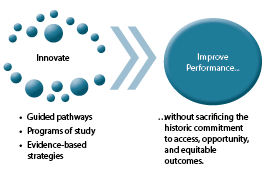This is the second post in a series about the Transformative Change Initiative(TCI), and is based on the 2014 TCI booklet. The series began with defining transformative change and scaling. The series will detail the seven guiding principles in the TCI Framework, and will provide snapshots of how TCI is supporting scaling and innovation through the TCI Network.
An impetus for TCI is the Trade Adjustment Assistance Community College and Career Training (TAACCCT) grant program. Beginning in 2011, the U.S. Department of Labor (DOL) began awarding nearly a total of $500 million per year to single institutions or consortia of colleges throughout the United States. Through highly competitive 3- or 4-year grants, colleges are required to recruit and assist Trade Adjustment Act (TAA)-eligible workers and other adults to participate in “undergraduate education and career training program strategies or to replicate existing designs, program development methods, and/or delivery strategies that have established evidence of successful implementation.”1
According to the DOL, TAACCCT aims to “ensure that our nation’s higher education institutions are able to help TAA-eligible workers and other adults acquire the skills, degrees, and credentials needed for high-wage, high-skill employment while also meeting the needs of employers for skilled workers.”
The TAACCCT grants support the implementation of pathways, programs of study, and evidence-based strategies that are linked to a wide range of occupations experiencing growth in the U.S. economy, including STEM, health care, business, and other fields. Evidence-based strategies include accelerated and contextualized developmental education; competency-based curriculum; online and open learning technologies; intensive student supports; industry-recognized stackable credentials; and career development and job placement, to name a few. By connecting strategies to pathways and program of study implementation, there is potential for systemic change on a national scale, but there is also the possibility to fall short. Whether such complex innovations will succeed is yet to be seen.
Will TAACCCT support capacity-building that results in improved student, organization and system performance? Will innovations associated with TAACCCT be scaled without sacrificing the historic commitment that community colleges have had to access, opportunity, and equitable outcomes? It’s too soon to know, but paying attention to the data will tell the story.
- U.S. Department of Labor, Employment and Training Administration. (2010). Notice of Availability of Funds and Solicitation of Grant Applications for Trade Adjustment Assistance Community College and Career Training Grants Program. Washington, DC: Author. Retrieved from http://www.doleta.gov/grants/pdf/taaccct_sga_dfa_py_12_10.pdf
